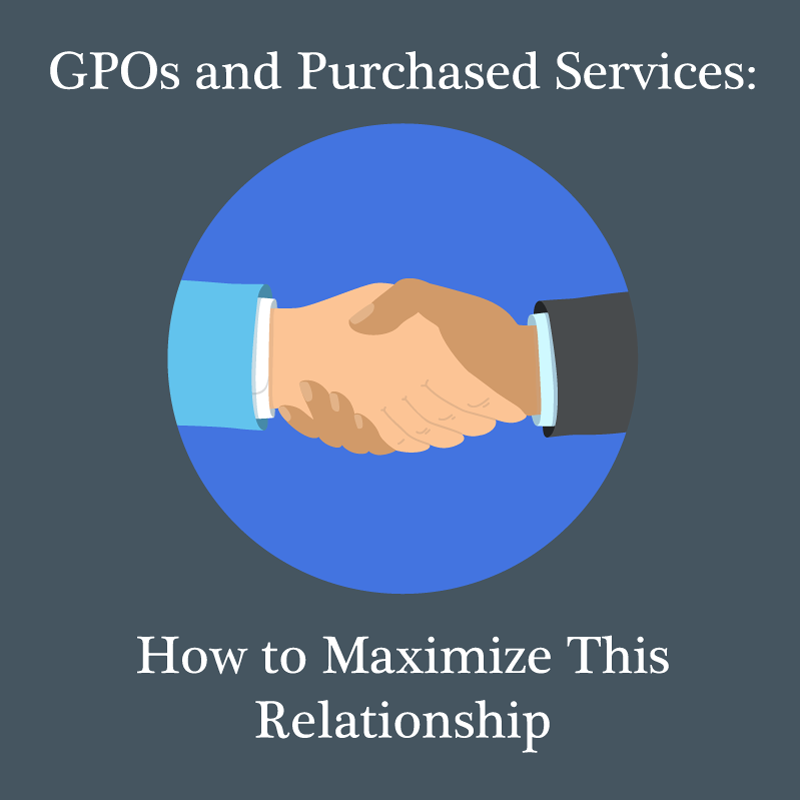Healthcare group purchasing organizations (GPOs) are very good at squeezing every penny out of the products you purchase. But for purchased services? Historically, not so much. Most GPOs simply lack the experience, tools, and know-how to effectively leverage their members’ spend data to find opportunities for savings when it comes to their purchased services expenses.
However, most GPOs do have some good purchased services categories and vendors under contract, if you know what to look for and how to take advantage of them.
Here are four ways to maximize value with your GPO for purchased services:
1. Check Their Contract Portfolio First
Before you do a local contract with a vendor for a service, make sure to check your national and regional GPOs’ portfolios first. If you haven’t checked in a while, you might be surprised to see how many categories and vendors are under contract now. Most of the GPOs have increased their focus in this area based on demand from their members. Since they can use their size to negotiate better pricing and terms than most hospitals can do on their own, I recommend looking at these vendors first.
You will most likely only find large, national vendors on contract and sometimes these contracts won’t have pricing in them, which is called a Master Terms Agreement (MTA). However, it is still better than starting from scratch typically. Some of the best purchased services categories that I have seen on a national GPOs portfolio are for IT Resellers, Medical Gas, Nurse Staffing, Food Distribution, Insurance, Reference Lab, and Wireless Services.
As noted before, there are advantages and disadvantages to accessing national purchased services contracts through your GPO compared to regional and local vendors.
2. Take Advantage of Support Services MTAs
As much as I really disliked the concept of MTAs a few years ago, I have now seen the light, as long as they are limited to support services categories. MTAs or Master Terms Agreements do not have pricing in them. They just have pre-negotiated, preferable terms and conditions. You will need to customize them for your specific needs, but they will typically be a better starting point than just your boilerplate language.
They typically work well if you decide to outsource one of these support services: Laundry & Linen, Food Services, Patient Transport, Environmental Services and Clinical Equipment Services (Biomed).
3. Explore Their Custom Sourcing Services
Taking the previous concept a step further, most (if not all) national GPOs offer custom sourcing services. They started offering these services as a way to compete against the rise of Regional Purchasing Coalitions (RPCs) who by definition negotiate customized agreements for their members. RPCs were getting better pricing for their members than the national GPOs could get on contract, so they had to do something.
You will most likely need to be a large member to get these services for free from the GPO unless the vendor agrees to pay the 3% admin fee or you are paying the GPO a contingency fee based on the savings the new agreement generates.
Either way, this is a great way to get a customized agreement that meets the specific needs of your health system. Surprisingly, the GPOs do not only do custom agreements with their contracted vendors; they will act like a standalone consultant through the process and contract with whichever vendor you select.
4. Look at Your GPO’s Branded Programs
This is where some of the best savings are hiding. Over the years, the GPOs realized that they could not contract effectively in certain categories for either regulatory/legal reasons or the vendors just simply were always going to be better at it than they were. This drove many GPOs to either buy or strategically partner with specialized vendors for these services. The GPOs then white-labeled the service (if they didn’t buy the company) and created “branded programs.”
The best example is Insurance Services. There is no GPO that started its own insurance and underwriting company; if they have an insurance program, it’s because they have strategically partnered with a vendor and rebranded it. But who cares what the name is as long as it is providing savings, and these programs provide BIG savings. Because the GPO has more lives they can put through the program than your employee population, you can typically save on average 10% on Life and Disability insurance for employees. These equal big numbers.
Another popular area is Energy Cost Management programs, which finds you the best energy rates if you are in a deregulated market. I have personally seen hospitals save millions of dollars when they worked with experts to time the market and lock in great rates.
Conclusion
Although GPOs traditionally were set up more for medical products and equipment purchasing rather than purchased services, there is no reason they should not expand their purchased services programs. By properly classifying and analyzing their members’ spend data to specifically call out the purchased services categories, the same skill that it takes to negotiate a better price for latex gloves and syringes can be brought to bear for services such as laundry and linen services and electricity. It’s worthwhile to explore the possibilities and expand the scope of the GPO’s offerings. In this age of relentless cost-cutting targets, how can you afford not to?

